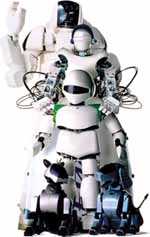TECH
KNOW
Robotic revelations
 |
From top to
bottom: Honda's Humanoid Robot P3, Temuzaku Communication Technology's
TMSUK04 robot, the Japan Science and Technology Corporation
Kitano Symbiotic Systems Project's Pino child robot and Sony's
Aibo
Courtesy of Robodex2000 |
Sanja Šuljagić speaks to Dr Edmund Ronald about Japanese robotics.
In this time of technological revolutions, computers have popped
up everywhere - homes, the workplace and even hair salons. More
and more people are becoming curious about new technology, and as
a result, robots have also increased in popularity. From mechanical
pets to automatons that look and act like humans, experts from around
the world are creating 'bots that not only look cool and provide
entertainment, but are useful in all areas of human existence. Dr
Edmund Ronald, a visiting researcher at the Swiss Federal Institute
of Technology, is a robotics expert that is well aware of the leaps
and bounds made in his field worldwide. TC asked Dr Ronald
to relay some of his opinions on the status of Japanese robotics
today, technically speaking.
Do you see any difference in your field between Japan and
the rest of the world?
Japan has much better and cheaper technology. Japanese firms (Sony,
Bandai, etc.) are bringing out entertainment robots today, selling
dancing dolls, prancing dogs and crawling bugs to kids in the mall.
On the other hand, in Europe, we do a lot of theoretical work on
future self-reproducing systems and artificial life. And in the
US, in the past, work was often military-funded and the goal was
to send robots into dangerous environments - like space - or outright
hostile situations like a future battlefield.
So, Japanese robots are friendly and playful?
That's right. Japanese researchers view every interaction as a social
interaction. While in the West a robot was often conceived as a
tool with a claw, in Japan researchers emphasize the personality
of their robots. You can see this trend with mobile phones, which
greet their users with a winking cartoon face when turned on, so
people will trust these new devices with their pleasant, friendly
faces and allow them into their homes. Today, a kid plays with its
Aibo. But tomorrow, the parents will notice the built-in TV camera
and optional wireless link, which could send pictures to them at
work, via the Internet, and reassure them about their offspring's
well-being. Putting a nice face on the technology makes it socially
acceptable and creates a market for it.
What fascinates you about Japanese robots?
The originality and variety of the work, as well as its technical
excellence fascinates me. The walking robots created by the Honda
Corporation and Waseda University are technically amazing. I have
also seen the Flute Playing Robot at Professor Takanishi's lab at
Waseda, a robot that plays on a real Yamaha flute, with air blown
from mechanical bellows through flexible lips. There is also a robot
set of jaws that can chew on food and evaluate its texture, as well
as a face that will blush when smoke is blown up its artificial
nostrils. You'll see some far out stuff in the States too, but I'd
say the robots here are more fun!
What is the future vision driving Japanese robotics?
It is that of a caring society, where a multitude of robots will
help the elderly in a variety of day-to-day situations - from the
simplest physical assistance for getting out of bed, to teleoperated
medical procedures. Robots in Japan are being invented to help humans
here on planet Earth, although I have a feeling that the entertainment
industry will reap the actual short-term economic benefits.
|